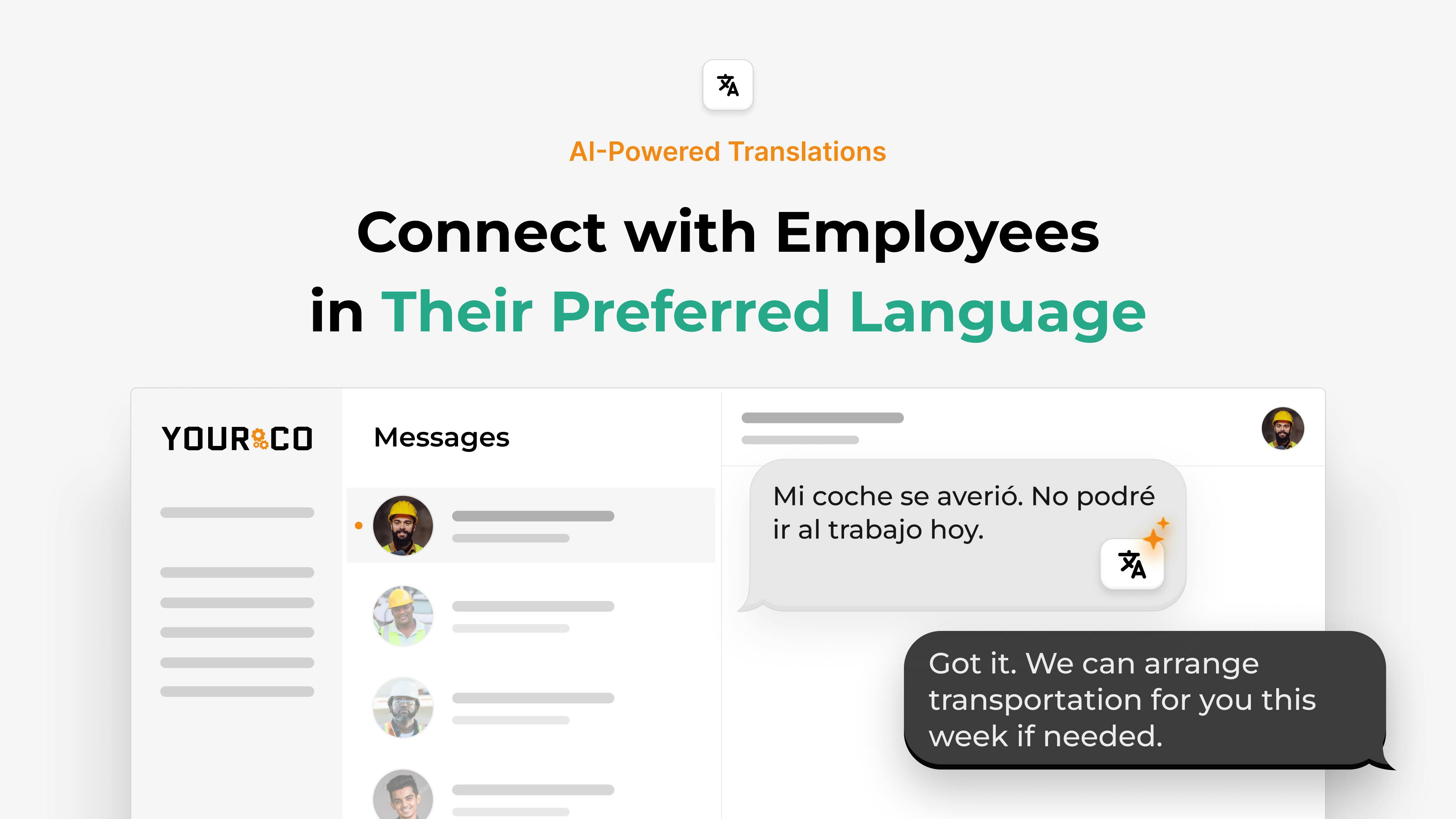Free Onboarding Templates in Vietnamese


Onboarding sets the tone for a new hire’s entire experience — and for Vietnamese-speaking employees, starting strong means providing clear, accessible materials from day one. Without them, even basic safety rules or HR policies can get lost in translation, leading to confusion, compliance risks, and slower productivity.
Free Vietnamese onboarding templates make it easy to give every new team member the information they need in the language they understand best. From first-day welcome texts to safety reporting prompts, these ready-to-use resources save managers time, reduce misunderstandings, and help employees feel respected and supported right away.
Why Clear Vietnamese Onboarding Templates Matter
Clear Vietnamese materials cut through confusion before it starts. Employers need to share safety rules, HR policies, and other essential information in a language workers understand, as misunderstandings can turn into injuries, missed wage steps, or compliance headaches. When you hand new hires documents they can actually read, you spend less time re-explaining basics and more time getting them productive.
Language is also about respect. Speaking to someone in their first language signals that you value their contribution from day one. Teams tell us that bilingual checklists, safety cards, and first-day texts build loyalty fast because employees feel seen, not sidelined.
Practical delivery matters just as much as translation quality. When onboarding Vietnamese-speaking employees, use short, conversational Vietnamese, avoid jargon, and push information through channels that fit non-desk roles. An SMS reminder the night before a shift works better than an email they might not check. A laminated poster by the timeclock gets seen every day. A printed orientation agenda tucked into a locker gives them something to reference when they're nervous.
Strong programs deliver faster speed-to-productivity, fewer early exits, and better safety outcomes for the entire crew. A clear Vietnamese toolkit keeps your operation running smoothly while building trust with your team.
What to Include in a Vietnamese Onboarding Toolkit
A comprehensive toolkit means having ready-to-use Vietnamese templates for every phase, from pre-boarding through 90-day check-ins. Each template should align with the established framework of compliance, clarification, culture, and connection, ensuring your messages build belonging while setting clear expectations.
Customize every template for your industry, whether you need machine-safety notes for manufacturing or guest-service guidelines for hospitality.
Language & Compliance Intake Form
Before training begins, capture which language each new hire understands best. A simple intake form records that preference up front, ensuring every policy, safety guide, and text alert reaches workers in Vietnamese from day one.
Yourco’s SMS surveys make it easy to collect language preferences and support needs from your team — quickly and at scale. Just send a short message asking, “Which language do you prefer for workplace messages?”
This approach supports both compliance and clarification needs while demonstrating your commitment to language access.
Template:
MẪU THU THẬP THÔNG TIN NGÔN NGỮ & TUÂN THỦ
Họ và tên nhân viên: ___________________
Bộ phận: ___________________
Số điện thoại: ___________________
1. Ngôn ngữ bạn muốn nhận tài liệu an toàn, chính sách và thông báo:
☐ Tiếng Việt ☐ Tiếng Anh ☐ Khác: ___________
2. Bạn muốn nhận thông báo hằng ngày qua:
☐ SMS ☐ Bản in
3. Bạn có cần hỗ trợ phiên dịch trực tiếp trong buổi đào tạo an toàn?
☐ Có ☐ Không
Tôi xác nhận thông tin trên là chính xác và sẽ báo HR nếu thay đổi.
Chữ ký nhân viên: ___________ Ngày: ___/___/____
Distribute this form during pre-boarding, file the signed copy in personnel records, and keep a digital backup. Having this document on file shows you made a good-faith effort to deliver critical information in a language employees understand. This reduces compliance risk and saves supervisors time explaining basics later.
First-Day SMS Welcome Message
A simple, friendly text sent before day one helps your new hire feel prepared and confident. Most employees check their phones regularly, making SMS more reliable than emails that often get missed. Send this message 24–48 hours before their first shift — early communication reduces first-day stress and helps new employees get productive faster.
Template:
"Xin chào [Tên] ! Chúng tôi rất vui được đón bạn gia nhập đội ngũ [Công ty]. Vui lòng có mặt lúc 7:45 sáng Thứ Hai, ngày [dd/mm] tại cổng chính (địa chỉ: [địa chỉ]). Mang theo CMND, giày kín mũi và sẵn sàng cho buổi hướng dẫn an toàn. Khi tới, gặp anh [Tên quản lý] số [điện thoại]. Hẹn gặp bạn!"
Keep your message short and clear so it translates well if managers need an English version too. For restaurant jobs, add uniform details. For warehouse work, mention specific safety gear to bring. This upfront clarity gives new hires exactly what they need to know, so they can focus on learning instead of worrying about logistics.
For best results when translating messages like these, follow proven SMS writing guidelines for translation to ensure clarity across languages.
Vietnamese Orientation Agenda
A first-day agenda in the employee's own language cuts guesswork and lets everyone dive straight into productive work. When new hires know exactly where to be and what comes next, anxiety drops, and you spend less time chasing people from station to station.
Clear day-1 structure also covers compliance needs like safety briefings and cultural elements like team introductions.
Sample template:
Mẫu lịch trình ngày đầu (bản gốc tiếng Việt)
- 07:45 – Có mặt tại cổng bảo vệ, nhận thẻ nhân viên
- 08:00 – Chào mừng & giới thiệu công ty
- 08:30 – Hướng dẫn an toàn & cấp PPE
- 09:15 – Tham quan khu vực làm việc
- 10:00 – Hoàn tất hồ sơ nhân sự
- 10:30 – Đào tạo quy trình công việc
- 12:00 – Ăn trưa cùng nhóm
Send this schedule by SMS the evening before, hand out a printed copy at the gate, and drop it in email for anyone who prefers digital. In a manufacturing plant you might extend the safety block; in hospitality, swap in a customer-interaction demo. However you tweak it, keep time slots realistic and leave space for questions so your new teammate ends the day confident and connected.
30/60/90-Day Success Plan
A written 30/60/90-day roadmap gives every new hire a clear destination and lets you and the employee measure progress together.
Milestone examples:
Mẫu kế hoạch 30/60/90 ngày
- 30 ngày: Xác nhận chứng nhận cơ bản, thu thập phản hồi, điều chỉnh kế hoạch đào tạo
- 60 ngày: Mở rộng đào tạo chéo, giới thiệu các module chất lượng và an toàn nâng cao
- 90 ngày: Đạt năng suất đầy đủ, cân nhắc nhân viên vào chương trình "buddy" cho khóa tuyển dụng tiếp theo
Print this one-page plan and review it on day one, then revisit it during quick check-ins at weeks two, four, and eight. Encourage employees to note questions or roadblocks directly on the document. This living record keeps conversations focused and shows progress at a glance.
For roles with heavy safety or customer interaction, swap in metrics that matter — first-pass yield for manufacturing or guest-satisfaction scores in hospitality. Have the employee explain each milestone back to you using the "teach-back" method. This confirms real understanding while building confidence. Delivering the plan in Vietnamese removes guesswork and sets the stage for a productive, engaged first quarter.
Day 7 & Day 30 Pulse Surveys
Early feedback in a language workers understand helps you catch problems before they get bigger. Building connection in the first month boosts retention, and quick surveys are one of the simplest ways to make that happen.
Day 7 Survey Questions:
Khảo sát Nhanh – Ngày 7
1. Trên thang điểm 1–5, mức độ rõ ràng về công việc của bạn hiện tại là bao nhiêu?
2. Bạn còn câu hỏi nào về an toàn, lương, hoặc lịch làm việc không?
3. Bạn có cảm thấy được hỗ trợ đầy đủ từ quản lý và người hướng dẫn không?
4. Điều gì sẽ giúp bạn làm việc tốt hơn trong tuần tới?
Day 30 Survey Questions:
Khảo sát Nhanh – Ngày 30
1. Trên thang điểm 1–5, bạn tự tin thế nào khi thực hiện nhiệm vụ hằng ngày?
2. Bạn có gặp khó khăn nào về giao tiếp hoặc tài liệu tiếng Việt không?
3. Bạn muốn đề xuất thay đổi gì để cải thiện đào tạo hoặc an toàn?
4. Có điều gì khác bạn muốn chia sẻ không?
Send each survey by SMS, paper handout, or a short digital form — whatever channel your crew uses most. Platforms that automate bilingual texting make delivery and follow-up much easier. Keep surveys anonymous to encourage honest answers, and review results with supervisors within 24 hours so you can fix issues while they're still fresh.
Add industry-specific questions when they matter — manufacturing teams might ask about PPE fit, while hospitality crews could rate guest-service training. When you act on the answers quickly, you show respect and keep new hires engaged.
Safety Incident Reporting Prompt
Clear, quick reporting keeps everyone safe and shows you take compliance seriously. A concise Vietnamese prompt posted at every station and sent by SMS during orientation reminds new hires exactly what to do the moment something looks wrong.
Template:
BÁO CÁO SỰ CỐ AN TOÀN NGAY
Dừng lại ngay nếu thấy nguy hiểm.
Nhắn "AN TOAN" kèm mô tả sự cố tới <số quản lý> hoặc gọi trực tiếp.
Nội dung cần: vị trí, thời gian, có ai bị thương, loại nguy hiểm.
Cảm ơn bạn đã chú ý an toàn và báo cáo sự cố ngay.
Post the prompt in work areas, break rooms, and inside PPE lockers; for field crews, schedule it as an SMS bookmark on day one. Multilingual safety materials like this reduce incident rates in manufacturing and logistics settings because employees no longer hesitate over wording or hierarchy before speaking up.
Tailor the contact line to each site — hospitality venues may route to the duty manager, while a factory directs reports to the EHS lead. When supervisors reinforce the prompt during daily communications, you create a culture where "Báo cáo sự cố ngay" is second nature.
Tips for Using These Templates Effectively
Start by keeping two versions of every document — Vietnamese for the employee and English for your files. Having both versions makes record-keeping easier and shows you're taking the right steps for compliance. Post the Vietnamese pages where people gather, slip copies into orientation binders, and tape quick-reference cards near equipment so no one has to hunt for instructions mid-shift.
Send Key Reminders By Text
Non-desk workers rarely check email, yet almost everyone sees an SMS within minutes. A short message that links to the safety handbook or first-week schedule works much better for frontline teams. Time these texts around shift changes, and keep sentences simple so any auto-translation stays accurate.
Respect Cultural Cues
Vietnamese workplaces value hierarchy and proper address forms. Using the right pronoun (anh, chị, em) signals respect and builds trust. Pair concise text with photos or icons — clear visuals help when people get tired of reading in a second language. If your team includes both Northern and Southern speakers, double-check translations for regional word choice.
Adjust for Regional Variations
Vietnamese has significant regional variations, with Northern (Hanoi) and Southern (Ho Chi Minh City) dialects containing different vocabulary and expressions. For workplace communications, be aware that technical terms may differ between regions. When possible, use standard Vietnamese terms accepted across regions, or create versions for each major dialect if your workforce includes significant numbers from different regions. Consider consulting with multilingual workplace communication experts to ensure your templates work for all Vietnamese speakers.
Track the Results
Monitor completion rates, quiz scores, and early feedback from new hires. Rising response numbers and fewer first-week questions mean your materials are hitting the mark. If confusion lingers, revise wording, add a sketch, or record a short explainer video and resend. Small tweaks improve clarity without starting over from scratch.
Streamline Onboarding Vietnamese Employees with Yourco
Clear Vietnamese onboarding materials remove guesswork, so new hires arrive confident, safe, and ready to contribute. When every first-day checklist, safety rule, and 90-day plan is written in their preferred language, you spend less time explaining basics and avoid costly mistakes.
Yourco makes delivering these materials simple. You can send welcome messages, training reminders, and feedback surveys straight to any phone, without needing an app or internet connection. With AI-powered translation in over 135 languages and dialects, your onboarding materials are instantly converted into clear, easy-to-understand Spanish. You can also choose manual translations when accuracy and context are especially important.
New hires can text photos of their ID, contracts, or tax forms directly to your company’s dedicated number. Built-in polling tools make it easy to run and track important day 7 and day 30 pulse surveys.
Ready to give your next hire a strong start? Try Yourco for free today or schedule a demo and see the difference the right workplace communication solution can make in your company.
FAQs
How do I know if my Vietnamese translations are accurate for workplace use?
Work with native speakers who understand workplace terminology, or use professional translation services for critical documents like safety procedures and HR policies. Yourco's AI-powered translations are designed specifically for workplace communication, reducing errors from slang or technical terms.
What's the best way to deliver Vietnamese onboarding materials to non-desk workers?
SMS works best for immediate updates and reminders since most workers check their phones regularly. Combine this with printed materials posted in common areas like break rooms and near time clocks. Avoid relying solely on email, as many frontline workers don't check it consistently. A multi-channel approach ensures everyone receives critical information regardless of their tech comfort level.
Should I create separate onboarding materials for Northern and Southern Vietnamese dialects?
For most workplace communication, standard Vietnamese works well across regions. However, be mindful of formal address terms (anh, chị, em) and consider regional preferences for certain words. If your workforce includes significant numbers from both regions, have representatives from each review your materials. Focus on clear, simple language that translates universally rather than region-specific expressions.
How can I track whether Vietnamese-speaking employees understand the onboarding materials?
Use the teach-back method during training sessions — have employees explain procedures back to you in their own words. Send brief SMS surveys in Vietnamese at day 7 and day 30 to gauge comprehension and gather feedback. Monitor completion rates for forms and training modules, and track early performance indicators like safety incidents or first-week questions. Quick response rates and fewer clarification requests usually indicate effective materials.



